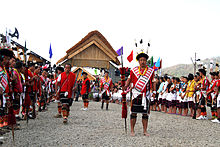- Naga hills
-
For the administrative units, see Naga Hills District.
 The Naga Hills are the traditional homeland of the Naga people.
The Naga Hills are the traditional homeland of the Naga people.
Naga hills, reaching a height of around 3825 metres, lie on the border of India and Burma (Myanmar). These hills are part of a complex mountain system, and the parts of the mountain ranges inside the Indian state of Nagaland and the Burmese region of Sagaing are called the Naga Hills.
In British India, Naga Hills was also the name of an administrative district of the British Raj.
The hills, due to their complexity and position form a barrier between the two countries. The Naga Hills are part of the Arakan Range (Rahkine Range) which to the north rise to 12,552 feet.
The term Naga refers to the Naga people who were called Naga or Naka in the Burmese language, which means 'people with pierced ears'.[1]
A part of the Naga Hills under the British Indian control was coalesced into a district in 1866.[2] The boundaries of this Naga Hills District were gradually expanded by annexation of the territories of several Naga tribes including the Aos (1889), the Semas (1904) and the Konyaks (1910). In 1912, the district was made part of the Assam province. After independence of India, it was merged with the Tuensang Division to create the state called Nagaland in 1963.[3]
Notes
- ^ Shimray, R. R. (1985) Origin and Culture of Nagas Pamleiphi Shimray, New Delhi, page 41, OCLC 14819323
- ^ Inato Yekheto Shikhu (2007). A re-discovery and re-building of Naga cultural values. Daya Books. p. 53-55. ISBN 9788189233556.
- ^ B. Datta-Ray, S. P. Agrawal (1996). Reorganization of North-East India since 1947. Concept. p. 6. ISBN 9788170225775.
Coordinates: 26°00′N 95°00′E / 26°N 95°E
Categories:- Nagaland
- India geography stubs
Wikimedia Foundation. 2010.
